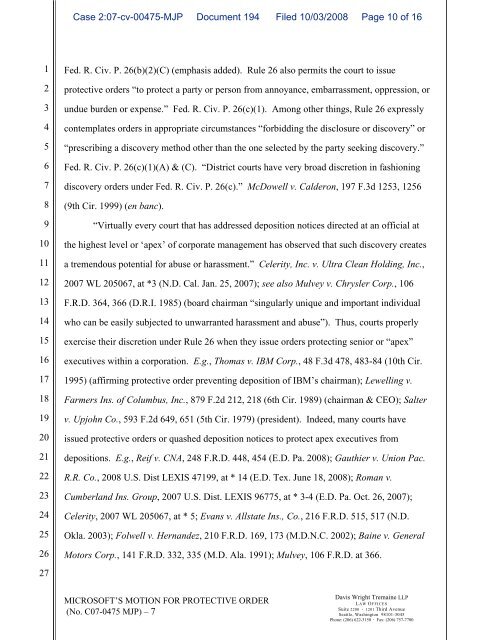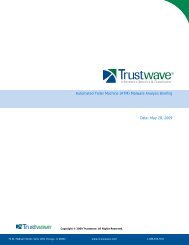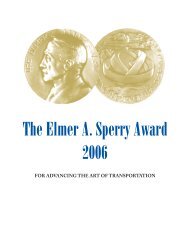filed under seal pursuant to protective order (dkt. 57)
filed under seal pursuant to protective order (dkt. 57)
filed under seal pursuant to protective order (dkt. 57)
Create successful ePaper yourself
Turn your PDF publications into a flip-book with our unique Google optimized e-Paper software.
Case 2:07-cv-00475-MJP Document 194 Filed 10/03/2008 Page 10 of 16123456789101112131415161718192021222324252627Fed. R. Civ. P. 26(b)(2)(C) (emphasis added). Rule 26 also permits the court <strong>to</strong> issue<strong>protective</strong> <strong>order</strong>s <strong>to</strong> protect a party or person from annoyance, embarrassment, oppression, orundue burden or expense. Fed. R. Civ. P. 26(c)(1). Among other things, Rule 26 expresslycontemplates <strong>order</strong>s in appropriate circumstances forbidding the disclosure or discovery orprescribing a discovery method other than the one selected by the party seeking discovery.Fed. R. Civ. P. 26(c)(1)(A) & (C). District courts have very broad discretion in fashioningdiscovery <strong>order</strong>s <strong>under</strong> Fed. R. Civ. P. 26(c). McDowell v. Calderon, 197 F.3d 1253, 1256(9th Cir. 1999) (en banc).Virtually every court that has addressed deposition notices directed at an official atthe highest level or apex of corporate management has observed that such discovery createsa tremendous potential for abuse or harassment. Celerity, Inc. v. Ultra Clean Holding, Inc.,2007 WL 205067, at *3 (N.D. Cal. Jan. 25, 2007); see also Mulvey v. Chrysler Corp., 106F.R.D. 364, 366 (D.R.I. 1985) (board chairman singularly unique and important individualwho can be easily subjected <strong>to</strong> unwarranted harassment and abuse ). Thus, courts properlyexercise their discretion <strong>under</strong> Rule 26 when they issue <strong>order</strong>s protecting senior or apexexecutives within a corporation. E.g., Thomas v. IBM Corp., 48 F.3d 478, 483-84 (10th Cir.1995) (affirming <strong>protective</strong> <strong>order</strong> preventing deposition of IBM s chairman); Lewelling v.Farmers Ins. of Columbus, Inc., 879 F.2d 212, 218 (6th Cir. 1989) (chairman & CEO); Salterv. Upjohn Co., 593 F.2d 649, 651 (5th Cir. 1979) (president). Indeed, many courts haveissued <strong>protective</strong> <strong>order</strong>s or quashed deposition notices <strong>to</strong> protect apex executives fromdepositions. E.g., Reif v. CNA, 248 F.R.D. 448, 454 (E.D. Pa. 2008); Gauthier v. Union Pac.R.R. Co., 2008 U.S. Dist LEXIS 47199, at * 14 (E.D. Tex. June 18, 2008); Roman v.Cumberland Ins. Group, 2007 U.S. Dist. LEXIS 96775, at * 3-4 (E.D. Pa. Oct. 26, 2007);Celerity, 2007 WL 205067, at * 5; Evans v. Allstate Ins., Co., 216 F.R.D. 515, 517 (N.D.Okla. 2003); Folwell v. Hernandez, 210 F.R.D. 169, 173 (M.D.N.C. 2002); Baine v. GeneralMo<strong>to</strong>rs Corp., 141 F.R.D. 332, 335 (M.D. Ala. 1991); Mulvey, 106 F.R.D. at 366.MICROSOFT S MOTION FOR PROTECTIVE ORDER(No. C07-0475 MJP) 7Davis Wright Tremaine LLPLAW OFFICESSuite 2200 1201 Third AvenueSeattle, Washing<strong>to</strong>n 98101-3045Phone: (206) 622-3150 Fax: (206) 7<strong>57</strong>-7700






